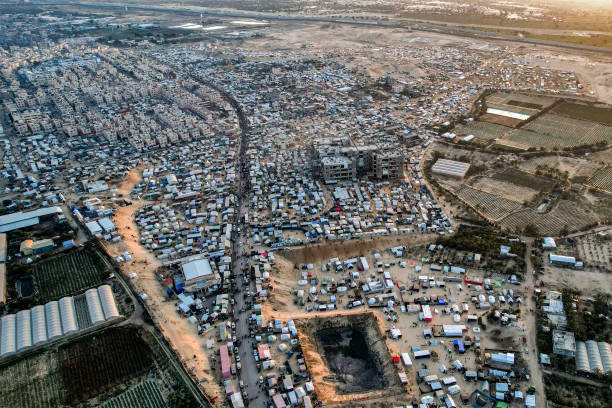Is Rafah in Egypt or Gaza? This question suddenly came up for discussion during ongoing war between Israel and Palestine. Rafah is a megacity that never stops captioning, especially when it comes to discussions about charitable causes and Middle Eastern geopolitics. However, many Americans might be wondering: Is Rafah in Gaza or Egypt? The solution is both simple and intricate. With an emphasis on American followership, this work seeks to elucidate Rafah’s political and geographic significance.
Is Rafah in Egypt or Gaza? What’s the geographical position?
Situated on the border between Gaza and Egypt, Rafah is a small town that is a part of the Palestinian homes. This split megacity is divided into two areas: the southern section is on the Sinai Peninsula in Egypt, and the northern part is in the Gaza Strip. Significant defenses against this geographic peak are made by the local populace as well as by international tactfulness.
Rafah is a crucial entry and departure gateway in Gaza, particularly considering that Israel and Egypt have been occupying the area since 2007. As the only point of entry into Gaza that is not under Israeli control, the Rafah Border Crossing is an essential conduit for people, supplies, and goods.
Rafah is a less inhabited region on the Egyptian side, but because of its proximity to the Gaza border, it is nevertheless strategically significant. By now, you must have figured out: Is Rafah in Egypt or Gaza?
Rafah’s literal and political environment
Rafah’s past is intricately linked to the larger Israeli-Palestinian conflict. First of all, after the Ottoman Empire fell and social powers divided up the dwellings, Rafah, a region within it, became a source of conflict. Rafah’s ultramodern division into Gazan and Egyptian neighborhoods resulted from the complicated political circumstances that followed World War II and the state of Israel’s founding in 1948.
There has been a great deal of fermenting on the Gaza side of Rafah, especially during the wars and confrontations between Palestinian and Israeli organizations. Military operations and leaguers have a significant impact on the area, posing charitable issues. There have also been problems on the Egyptian side of Rafah, especially with security firms connected to the uprising in Sinai.
How big is Rafah Gaza?
You must also be searching for how big is Rafah Gaza? Here’s the answer. Situated in the southern region of the Gaza Strip, Rafah is a noteworthy megacity in terms of both its magnitude and its geopolitical importance. With a land area of about 23 square miles, Rafah is home to over 150,000 people.
The vast landscape of the megacity is made up of agricultural land, densely populated areas, and busy requests. Rafah is an important hub for trade and transportation because of its advantageous location close to the Egyptian border, even in the face of obstacles from powerful political figures and shady players. Rafah is a crucial mecca in the Gaza Strip, and its geography, size, and population all support this.
Who controls the Rafah crossing?
It’s very important to know that who controls Rafah crossing? The Egyptian authorities are principally in charge of the Rafah Crossing, which is a crucial point of passage between Egypt and the Gaza Strip.
The crossing is Gaza’s primary point of contact with the non-Israeli outside world, although its operation is greatly impacted by the political climate in the area. Egypt is in charge of overseeing the security of the border as well as the influx of people and goods, usually working with the Palestinian Authority.
However, the management and operation of the crossing may alter due to factors rooted in the larger geopolitical environment, such as the dynamics between Egypt, Israel, the Palestinian Authority, and Hamas, the organization in charge of Gaza.
This control plays a major role in the stability and day-to-day functioning of Gaza, as it is essential for trade, humanitarian relief, and the movement of Gaza’s citizens. So it’s a little bit difficult to answer who controls Rafah crossing. Because it may alter, but it is mostly controlled by Egyptian authorities.
The Strategic Importance of Rafah
Rafah is strategically significant due to its location on the border between Egypt and Gaza for a number of reasons. The Rafah Border Crossing is vital to Gaza’s around two million inhabitants. Because of Israel’s stringent inspections, the crossing is vital for the transportation of building supplies, medical supplies, and other necessities that are often in limited supply.
Maintaining control of Egypt’s side of Rafah is crucial for public safety. The Sinai Peninsula has acted as a haven for militant activity, and the Egyptian government essentially police the border to help with the smuggling of weapons and the movement of zealots. Furthermore, with Rafah acting as the focal point of these negotiations, Egypt often thwarts ceasefires and deals because it has a political stake in the Israeli-Palestinian conflict.
As we already know, how big is Rafah Gaza. It’s a megacity divided between Gaza and Egypt, with each region having unique difficulties and importance. Due to its border location, it serves as a regional hub for security, tact, and charitable giving.
Rafah is an important example of how topography may affect political and philanthropic dynamics for Americans attempting to comprehend the complexities of Middle Eastern geopolitics. Rafah continues to be a megacity of utmost importance, regardless of the daily lives of its citizens or the larger counteraccusations for peace and security.
It’s crucial to consider the following as we keep an eye on events in this area: What effect will Rafah’s future have on the larger effort to bring peace and stability to the Middle East?
For more updates and insights, visit STATESIDESTORY.CO.IN.
